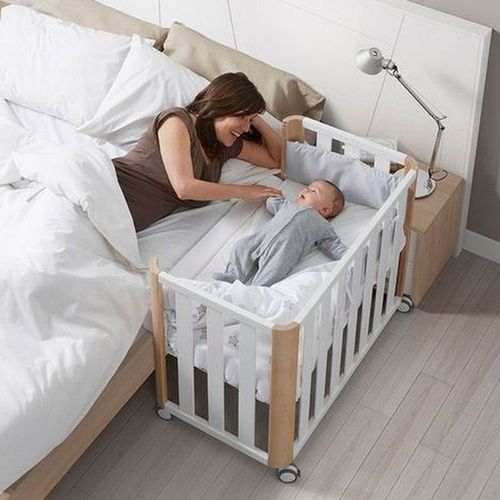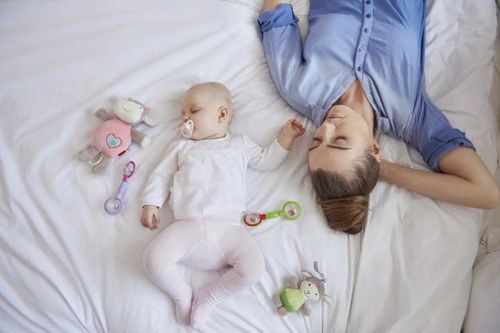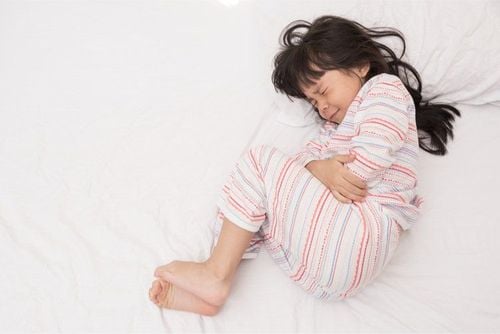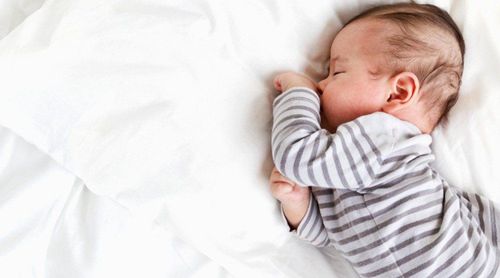This is an automatically translated article.
The article was professionally consulted by Specialist Doctor I Nguyen Thi My Linh - Neonatologist - Department of Pediatrics - Neonatology - Vinmec Danang International General Hospital.1. How to keep baby safe sleeping?
Until 1 year of age, babies should sleep on their backs for all of their sleep. Because of this, there is a much lower risk of dying from SIDS than babies who sleep on their belly or sides. Some parents worry that their baby will choke on his back, but the baby's airway anatomy and gag reflex will prevent that from happening. Even babies with gastroesophageal reflux disease (GERD) should be placed on their backs.Newborns should be placed skin-to-skin with their mother as soon as possible after birth, at least for the first hour. Then, when the mother needs to sleep, the baby should be placed alone in the crib. If your baby has breathing problems, they can be placed on their stomach temporarily and should be placed on their back as soon as the problem is resolved so they can get used to lying on their back. You should always lay your baby on his back, but if he's comfortable rolling both ways, you don't need to put him on his back. However, make sure that there are no blankets, pillows, stuffed toys or pads around, so that your baby doesn't roll into any items, which can cause airflow obstruction.
If your baby falls asleep in a car seat, stroller, or swing, you should move him to a firm sleeping surface as soon as possible. Use a firm sleeping surface. A portable crib that meets the Consumer Product Safety Commission (CPSC) safety standards is recommended along with a sturdy mattress, and is fitted specifically for the specific product. there. Don't put anything else inside the crib while your baby is lying down. A firm surface is a hard surface that won't sink when your baby lies on it.
Trắc nghiệm: Sự phát triển tinh thần, vận động của bé thế nào là đúng chuẩn?
Khi nào bé biết nói, biết hóng chuyện hay biết cầm cốc là "đúng chuẩn"? Điểm xem bạn biết được bao nhiêu mốc phát triển tinh thần, vận động "đúng chuẩn" của bé nhé!The following content is prepared under supervision of Thạc sĩ, Bác sĩ y khoa, Ma Văn Thấm , Nhi , Phòng khám Đa khoa Quốc tế Vinmec Dương Đông(Phú Quốc)
For the first 6 months or ideally in the first year, you should place a crib, bassinet, portable crib in your bedroom or near your parents' bed. The American Academy of Pediatrics recommends sharing, which reduces the risk of SIDS by up to 50% and is much safer than letting your baby sleep in the same bed as their parents. In addition, this will make it easier for you to feed, play with, and watch over your baby.
Only bring your baby to your bed when you are nursing and when you are not sleepy. Put your baby back in his or her own sleeping space when you feel sleepy. If you are in a drowsy state, make sure that there are no pillows, sheets, blankets or any other items that could cover your baby's face, head and neck, or overheat. As soon as you wake up, move your baby to his bed. Never put your baby to sleep on the couch, sofa or armchair. This is an extremely dangerous place for a baby to sleep.

Your baby is younger than 4 months old; Your baby was born prematurely or with low birth weight ; You or anyone else in bed is a smoker (even if you don't smoke in bed); The baby's mother smoked during pregnancy; you are taking any medicine that can make it harder for you to wake up; You are drinking; You are not the baby's parent; Soft surface, such as water bed, old mattress, sofa, couch or armchair; There are soft beds like pillows or blankets on the bed. Keep soft objects, or any object that could increase the risk of entrapment, suffocation, or strangulation, out of your baby's sleeping area. These include pillows, blankets, blankets, toys, pads or similar products that attach to the crib rails or sides. If you're worried about your baby getting cold, you can use infant sleepwear, such as a wearable blanket.
This blanket is great for swaddling your baby. However, make sure the baby is always on his back when swaddled. The swaddling should not be too tight or make it difficult for your baby to breathe or move his or her hips. When your baby feels uncomfortable, tense up, you should stop swaddling.
Try giving a pacifier at nap time and bedtime. This helps reduce the risk of SIDS, even if it falls off after the baby is asleep. If you are breastfeeding, wait until breastfeeding is over before giving your baby a pacifier. This usually takes 2-3 weeks. If you are not breastfeeding, you can give your baby a pacifier whenever you want. If the pacifier falls out after your baby sleeps, you don't need to put it back on.

2. How to make sure babies sleep safely
Sudden infant death (SIDS) is a reality that no parent wants to encounter. Not all cases of SIDS can be explained or prevented, but experts say following these safe sleep guidelines can significantly reduce the risk of sleep-related death. baby's.Put baby to sleep on his back: Until he turns 1 year old, whether he naps or sleeps at night. If baby rolls over, gently place him on his back once. Sleep on a flat and firm surface: Your baby should sleep on a firm, flat surface that won't move when he's on it. This can be a crib, bassinet, or portable crib with a mattress and rigid sheet designed to match the product. Never let your baby sleep on the sofa, couch or armchair. Keep the sleeping surface tidy: Remove blankets, toys, cushions, and any other objects from your baby's sleeping area. These increase the risk of entrapment and suffocation. Move your baby if necessary: If your baby sleeps in a car seat, stroller, swing, or other uneven surface, move him or her to a firm, flat sleeping surface, and lay him or her down. upside down as soon as possible. Share a room, but not a bed: The AAP recommends keeping your baby's crib or other sleeping place near your bed for at least the first 6 months. But don't let your baby sleep in your bed. If your baby falls asleep while you are feeding or comforting him in your bed, move him to his bed. Breast-feeding: Breastfeeding has been shown to reduce the risk of SIDS. Ideally, breastfeed your baby exclusively for the first 6 months of life and continue breastfeeding after your baby starts solids until he or she is at least a year old.

To prevent diseases that babies often get, parents should pay attention to nutrition to improve children's resistance. At the same time, add supporting foods containing lysine, essential micro-minerals and vitamins such as zinc, chromium, selenium, B vitamins,... snacks and less digestive problems.
Parents can learn more:
Why do you need to supplement Lysine for your baby?
The role of zinc - Guidelines for reasonable zinc supplementation
Please visit the website Vinmec.com regularly and update useful information to take care of your baby and family.
Reference source: babycenter.com
Recommended video:
How to wrap a baby's nest















